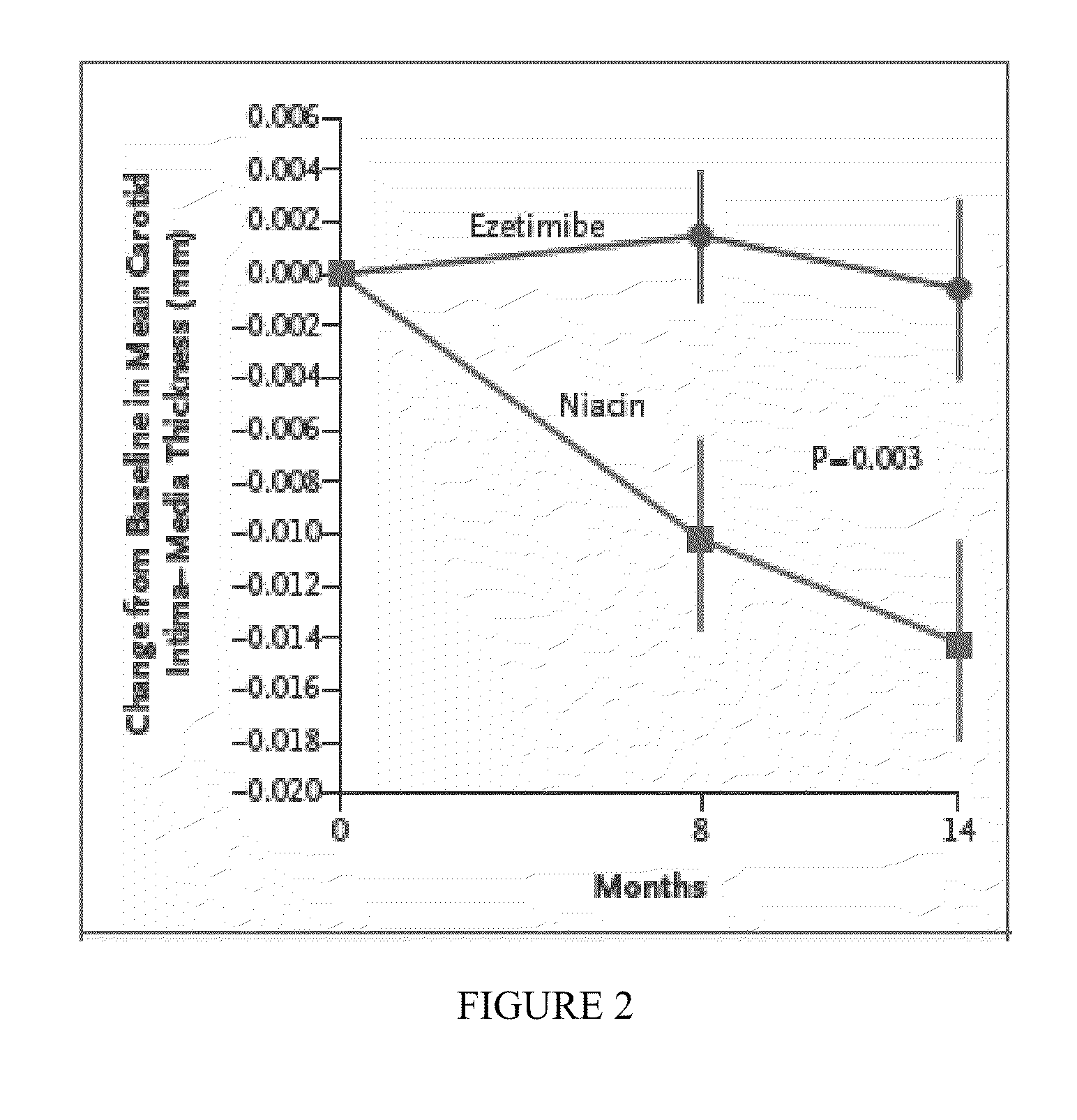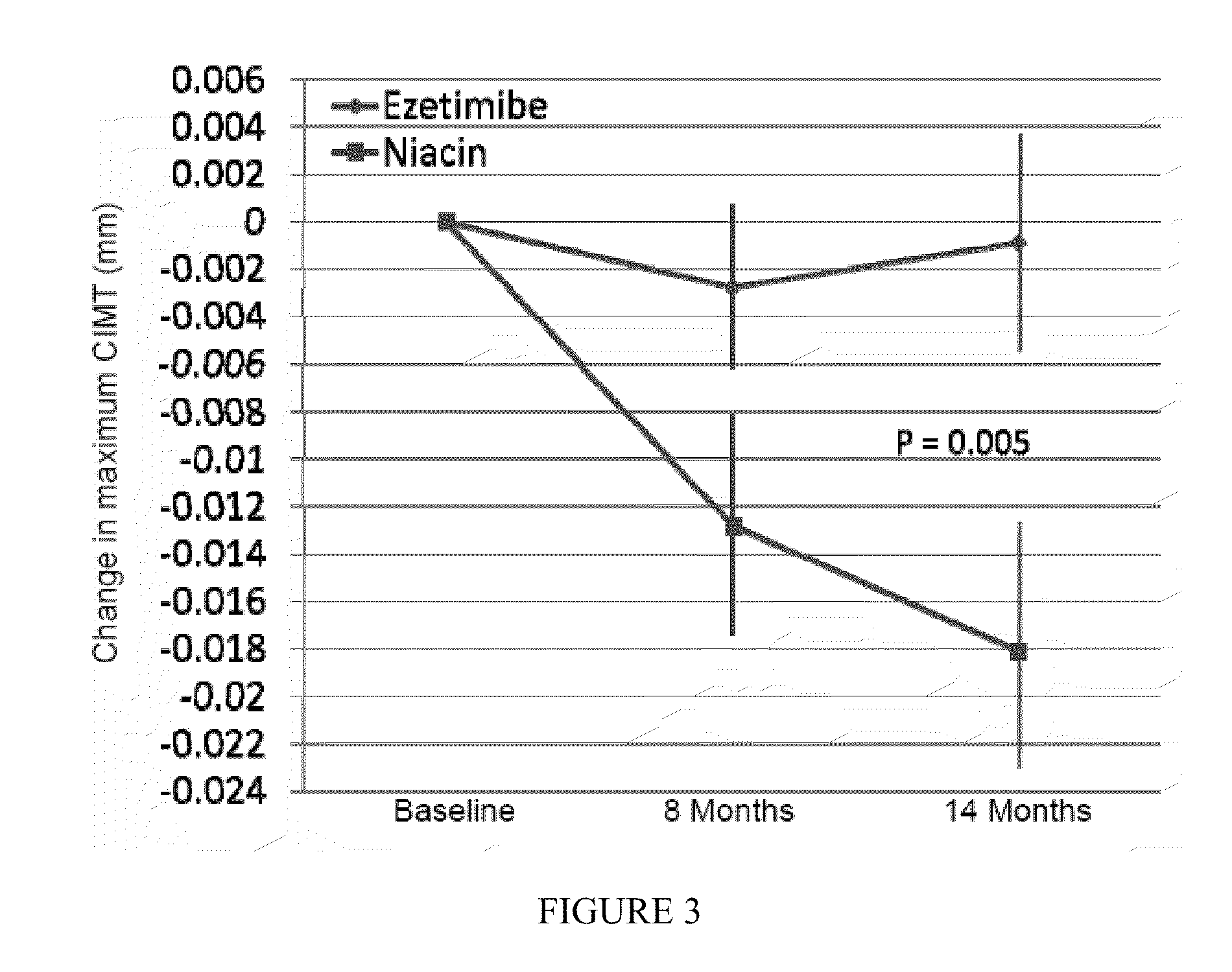Method for treatment of atherosclerotic disease
a technology for atherosclerosis and treatment methods, applied in the direction of biocide, cardiovascular disorders, drug compositions, etc., can solve the problems of inability to demonstrate the additive effect of niacin to statin, unknown and unpredictable whether combination therapy can achieve any reduction in the progression, etc., to achieve enhanced regressive effect of atherosclerosis
- Summary
- Abstract
- Description
- Claims
- Application Information
AI Technical Summary
Benefits of technology
Problems solved by technology
Method used
Image
Examples
example 1
Methods
[0026]Study population: This prospective, randomized, parallel group, open-label, blinded endpoint study was conducted at two centers, Walter Reed Army Medical Center, a university-affiliated, suburban, tertiary care military medical center, and the Washington Adventist Hospital, a private tertiary care hospital located in Takoma Park, Md. The institutional review boards of each facility approved the study, and all volunteers provided written, informed consent. Included subjects were men and women ≧30 years old with either known atherosclerotic coronary or vascular disease (N=279) or a coronary risk equivalent diagnosis including diabetes mellitus (N=38), a 10-year coronary heart disease Framingham risk score ≧20% (N=26), or a coronary calcium score above 200 or 400 (N=20) for women and men respectively. Eligible participants were required to be treated with a stable dose of statin monotherapy with a lipid panel within the past 3 months demonstrating both an LDL-C <100 mg / dL ...
example 2
Results
[0033]Baseline characteristics of the subjects who had completed the trial at the time of its termination within the 2 treatment groups were similar (N=208; Table 1). The study population was 80.2% male, 65±11 years old, treated with primarily simvastatin or atorvastatin (90.9%) at a mean dose of 42±25 mg for 6±5 years. Baseline total cholesterol was 147±26 mg / dL, LDL-C 82.1±23.1 mg / dL, HDL-C 42.4±8.5 mg / dL, and TG 134±68 mg / dL. Baseline mean and maximum CIMT were 0.9088±0.1583 mm, and 1.0179±0.1653 mm.
TABLE 1Baseline Characteristics of 208 Patients Randomly Assigned toEither Extended Release Niacin or Exetimibe Who Completed the14 Month CIMT Assessment, According to the Treatment Group *EzetimibeNiacinN = 111N = 97PMale gender91(82)76(78.4)0.51Age, mean ± SD 65 ± 11 64 ± 110.49Diabetes mellitus (n, %)44(39.6)31(32.0)0.25Hypertension (n, %)96(86.5)82(84.5)0.69Tobacco use (n, %)5(4.5)6(6.2)0.86Family history of coronary heart disease (n, %)42(37.8)48(50.0)0.09History of corona...
example 3
Further Analysis and Results
[0041]After the initial study termination, all actively enrolled patients were contacted and returned for final collection of clinical variables, laboratory data, and blinded CIMT assessment. Among the 363 patients initially enrolled in the trial, 208 patients had completed the entire 14 months of the study period at the time of their final visit (111 ezetimibe, 97 ERN), and 44 had left the study. Final ultrasound examinations could not be obtained in 4 additional subjects after termination of the study (total of 48 participants dropped out), leaving 315 patients for this analysis. In 107 of the 315 patients analyzed, final achieved lipid values and CIMT measurements were performed after study termination at a mean treatment duration of 7±3 months, and these values are included in the primary end point (a last observation carried forward analysis).
[0042]The baseline characteristics of the 363 patients enrolled in the trial were similar between the 2 treat...
PUM
| Property | Measurement | Unit |
|---|---|---|
| Time | aaaaa | aaaaa |
| Time | aaaaa | aaaaa |
| Time | aaaaa | aaaaa |
Abstract
Description
Claims
Application Information
 Login to View More
Login to View More - R&D
- Intellectual Property
- Life Sciences
- Materials
- Tech Scout
- Unparalleled Data Quality
- Higher Quality Content
- 60% Fewer Hallucinations
Browse by: Latest US Patents, China's latest patents, Technical Efficacy Thesaurus, Application Domain, Technology Topic, Popular Technical Reports.
© 2025 PatSnap. All rights reserved.Legal|Privacy policy|Modern Slavery Act Transparency Statement|Sitemap|About US| Contact US: help@patsnap.com



